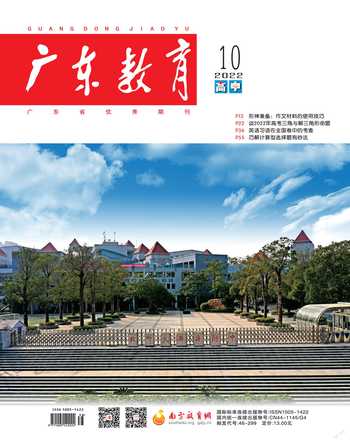利用流程图解决语法填空谓语动词题
董睿



语法填空中谓语动词的考查是重点,一篇语填中常考查1-2个谓语动词,有时甚至3个(2020年新高考I),要求考生对所填谓语动词的时态、语态和主谓一致三个方面均判断正确,因此对考生而言具有一定难度。尽管考生也知道需要考虑这三方面,但实践起来常常会漏掉三方面中的一个、甚至是两个,或者是判断不准确,这体现了考生在做题的思维流程方面还有一定欠缺。本文从考生做题实际出发,专注于在判断出该填谓语动词之后的做题思维流程图,以辅助考生养成良好做题习惯。
一、时态的思维导图设计
时态是三方面当中最常考的,判断依据常见的有:
1)时间状语:根据句中出现的时间状语确定时态。
[例1.1](2018全国卷II)Since 2011, the country _________(grow)more corn than rice.
解析:答案为has grown。根据上文Since 2011可知用现在完成时;根据句意“2011年以来,中国种植的玉米比水稻多”可知语态是主动语态;根据主语the country可知谓语动词应该用单数;综上,答案为has grown。
2)上下文语境:上下文没有具体的时间状语,但可以根据语境综合判断,尤其关注上下文的其他谓语动词的时态。
[例1.2](2019全国卷II)Picking up her“Lifetime Achievement”award, proud Irene _________(declare)she had no plans to retire from her 36-year-old business. Irene said,“I dont see any reason to give up work....”
解析:答案为declared。虽然此句没有时间状语,但根据后文其他谓语动词had以及said可知,用一般过去时态,根据句意可知语态为主动,故填declared。
[例1.3](2017全国卷II)Steam engines _________ (use)to pull the carriages and it must have been fairly unpleasant for the passengers, with all the smoke and noise. However, the railway quickly proved to be a great success and within six months...
解析:答案为were used。虽然此句没有时间状语,但根据语境,蒸汽发动机是在过去被使用的,且后文proved是过去式,所以此处也是过去式;同时根据句意“蒸汽发动机被运用”可知是被动语态;主语是steam engines,谓语动词用复数;所以填were used。
3)固定句型:根据固定搭配直接确定。
①主将从现(时间、条件、让步状语从句)
[例1.4]I _______(go)to the party as soon as I finish my homework.
解析:答案为will go,根据时间状语从句主将从现规则可知,此处应用一般将来时。
②That/It is the first/second...(序數词)time that...句型中用现在完成时
[例1.5]It is the second time that I _______(read)the book.
解析:答案为have read,根据It is the second time that可知,此处应用现在完成时,表主动,第一人称,故答案为have read。注意,若此句型变为It was the first/second...time that...,则从句中应使用过去完成时had done。
综上,时态的思维导图设计可如下图所示:
二、语态的思维导图设计
语态是三方面当中考生最常遗忘的,判断依据常见的有:
1)主语与谓语动词的关系:若主语为动作发出者,则为主动语态;若主语为动作承受者,则为被动语态。
[例2.1](2018全国卷II)The Chinese Ministry of Agriculture finds that between 2005-- when the government __________(start)a soil-testing program that/which gives specific fertilizer recommendations to farmers -- and 2011, fertilizer use dropped by 7.7 million tons.
解析:答案为started。根据时间状语2005年可知用过去时;根据句意“在2005年政府开始了一项土壤测试项目”可知,主语government是动作start的发出者,故语态是主动语态;综上填started。
[例2.2](2019全国卷III)On the last day of our week-long stay, we __________(invite)to attend a private concert on a beautiful farm on the North Shore under the stars, listening to musicians and meeting interesting locals.
解析:答案为were invited。根据时间状语判断时态为一般过去时;根据句意“我们被邀请去参加一场私人音乐会”可知,主语we是动作invite的承受者,故语态是被动语态;主语为we;故填were invited。
在分析主语与谓语动词的关系时,有一个特别有帮助的标志词,就是介词by,它通常引出动作的执行者,所以在介词by前面需要填写的谓语动词,可以先考虑是不是被动语态。
[例2.3] The World Wide Web is composed of different websites, which __________(create)by people and organizations around the world.
解析:答案为are created。根据上下文语境可知用一般现在时;根据空格后面“by people and organizations”可知,by引导出了动作create的执行者people and organizations,所以which所代指的先行词是create的承受者,故用被动语态;从句主语是which代指的先行词websites,为复数;可知答案是are created。
2)主动表被动:特殊情况下,可用主动的形式表被动,情况较多,最为常见的是以下两种:
①“系动词look, sound, feel, smell, taste等+adj”构成的系表结构常用主动表被动。
[例2.4] This apple ________(taste)sweet.
解析:答案为tastes。根据语境可知时态应用一般现在时;此处系动词taste的用法为主动表被动;主语为单数;综上,填tastes。
②某些可以和easily, well等副词连用的不及物动词,如read, write, draw, wash, cook, clean等,也可用主动表被动。
[例2.5] As we can see, the traffic sign ________(read)very clear.
解析:答案为reads。根据语境可知描述的是一般情况,时态应用一般现在时;此处系动词read的用法为主动表被动;主语为单数;综上,填reads。
3)含有固定搭配的被动语态:如be made of, be devoted to, be absorbed in, be dressed up等。
[例2.6](2016全国卷III)Truly elegant chopsticks might ________(make)of gold and silver with Chinese characters.
解析:答案为be made。固定搭配be made of 表示“由……制作而成”,根据空格前面的情态动词might可知,这里填be made即可。
[例2.7] Every time she went to a party, she would always ________(dress)up as a princess.
解析:答案为be dressed。固定搭配be dressed up as表示“打扮成……”,根据空格前面的情态动词would可知,这里填be dressed即可。(注:此处若不注意固定搭配,非常容易认为是主动语态,而填写dress。)
综上,语态的思维导图设计可如下图所示:
三、主谓一致的思维导图设计
主谓一致是三方面当中较为简单的一方面,但如果遇到长难句,考生必须准确分辨出主语。同时还有一些特殊用法,考生也必须牢记于心。主谓一致的判断依据常见的有:
1) 语法一致原则
[例3.1](2017全国卷III)Sarah says, “My dad thinks I should take the offer now. But at the moment, school __________(come)first.”
解析:答案为comes。根据上下文的时态可知,这里要用一般现在时;根据句意可知语态是主动;主语是school,为第三人称单数,故谓语动词用动词三单形式。
2)意义一致原则
[例3.2] The police __________(question)the suspects at the moment.
解析:答案為are questioning。根据下文的时间状语at the moment可知,这里要用现在进行时;根据句意可知语态是主动;主语是The police,虽然形式为单数,但意义为复数,故谓语动词用复数,综上,填are questioning。
3)就近原则
[例3.3] Not only you but also I __________(be)responsible for the accident yesterday.
解析:答案为was。根据not only...but also...就近原则可知,be的变形以I为准,同时根据下文的时间状语yesterday可知填was。
综上,主谓一致的思维导图设计可如下图所示:
四、谓语动词思维流程图的具体运用
将时态、语态及主谓一致三方面的思维导图整合为做题思维流程图如下:
现通过具体例子展示如何运用这一思维流程图:
[例4.1](2020新高考I)The parts of a museum open to the public __________(call)galleries or rooms. Often, only a small part of a museums collection is on display. Most of it is stored away or used for research.
解析:
[例4.2](2019全國卷I)In recent years some Inuit people in Nunavut __________(report)increases in bear sightings around human settlements, leading to a belief that populations are increasing.
解析:
[例4.3](2017全国卷I)When fat and salt __________(remove)from food, the food tastes as if it is missing something.
解析:
值得注意是,be动词是近年来的考查重点:
■(2021新高考I)What comes next is the endless series of steps. You cant help wondering how hard it _______(be)for the people then to put all those rocks into place.
■(2021新高考II)One of the biggest companies I wrote to _______(be)Alaska Airlines Paris.
■(2019全国卷I)Of the nineteen recognized polar bear subpopulations, three are declining, six ______(be)stable, one is increasing, and nine lack enough data.
■(2018全国卷I)While running regularly cant make you live forever, the review says it _______(be)more effective at lengthening life than walking, cycling or swimming.
■(2017全国卷I)Fast food _______(be)full of fat and salt; by eating more fast food people will get more salt and fat.
从历年的高考真题来看,相比于实义动词,be动词的考察更简单,只需考虑时态和主谓一致,以2021年的两道题为例:
[例4.4](2021新高考I)What comes next is the endless series of steps. You cant help wondering how hard it _______ (be)for the people then to put all those rocks into place.
解析:
[例4.5](2021新高考II)One of the biggest companies I wrote to _______(be)Alaska Airlines Paris.
解析:
尽管完整的思维流程图看起来内容较多,但在实际做题时,考生不必将完整的流程图画出,只需要在草稿纸或脑海中构建好做题流程,并按照流程进行思考关键点即可,并不需要花费大量时间,同时也能保证思考的完整性,不漏掉时态、语态和主谓一致的任一方面,从而提高做题正确率。
责任编辑 吴昊雷

